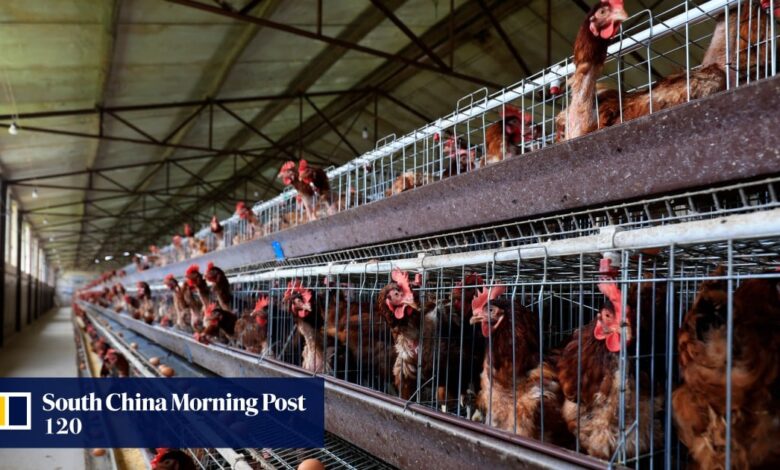China’s ‘best defence’ is poultry vaccine as bird flu spreads from Europe, Africa

[ad_1]
Lead author Vijaykrishna Dhanasekaran, who heads the HKU pathogen evolution lab, urged China to guard against strains of the virus arriving from Europe by keeping up its vaccination programme against bird flu infections among the country’s flocks.
Why sick minks are reigniting worries about bird flu spreading to humans
Why sick minks are reigniting worries about bird flu spreading to humans
“Especially since the emergence of H7N9 in 2013 … the control in China has become really good with mass application of H5 and H7 vaccines. That is one of the reasons the recent resurgence was not in China,” he said.
“They need to sustain it because now the viruses are coming back from Europe. [China should] continue the vaccination system so that we can keep eliminating the virus.”
H5N1 first emerged in China in 1996 and was the first virus to establish sustained transmission in domestic poultry. After years of being largely confined to Asian poultry networks, recent outbreaks have emerged further afield.
On the rare occasions the virus appeared in Europe and Africa, it was carried there by wild birds but would die out after a few months because H5N1 was not as adaptive to wild populations.
“However, in the past two years we have seen extensive outbreaks – they’re doubling,” said Dhanasekaran, who is also an associate professor with the HKU School of Public Health.
“It’s an environmental disaster in terms of the number of wild birds that have been infected. The virus is also spreading to new regions via these migratory flyways,” he said.
‘Extremely rare’ case of bird flu in human detected in England
‘Extremely rare’ case of bird flu in human detected in England
In September, three adult harbour seals in Puget Sound, on the northwestern coast of Washington state tested positive for the H5N1 virus, according to the US National Oceanic and Atmospheric Administration.
It was the first time the highly pathogenic bird flu was reported in marine mammals on the US West Coast.
Last month, concerns were raised that penguins and other local species could be at risk after H5N1 was detected in the Antarctic region for the first time.
The virus was probably carried to Antarctica by migratory birds returning from South America, where there has been a high number of bird flu cases, according to the British Antarctic Survey.
Bird flu detected in Antarctica region for first time
Bird flu detected in Antarctica region for first time
Dhanasekaran said that the H7 and H9 virus groups mainly infect chickens, while the biggest difficulty in controlling the H5 viruses is that they affect aquatic and terrestrial poultry differently.
“When [H5] is infecting … poultry, it can kill chickens but it does not kill ducks. It is naturally adapted to ducks so when it is circulating in the live bird markets, we can never be sure until it infects chickens and they start dying,” he said.
The paper warned that the scale of H5 outbreaks in wild birds had been escalating beyond Asia since 2014. The researchers said recent incidences in African and European bird populations suggested the epicentre had also extended beyond the Asian region.
“It is necessary to enhance global surveillance and improve multifaceted mitigation strategies for outbreak prevention and response,” the scientists said.
Bird flu outbreak: 500,000 chickens die in Burkina Faso
Bird flu outbreak: 500,000 chickens die in Burkina Faso
The World Health Organization recorded 1,566 cases of human infection and at least 613 deaths from the H7N9 virus between 2013 and 2018. China remained the epicentre of the virus until 2016.
A 2021 study by the State Key Laboratory of Veterinary Biotechnology in Harbin, northern China, identified five waves of human infection caused by the H7N9 bird flu virus, and confirmed that it caused only mild infections in ducks while being highly lethal to chickens.
The Harbin researchers noted that “further human cases have been successfully prevented since September 2017 through the use of an H7N9 vaccine in poultry” but the virus had not been eradicated from poultry.
They found that the H7N9 viruses isolated in 2019 were antigenically different from the vaccine strain used to control the virus in poultry. “Replication of these viruses cannot therefore be completely prevented in vaccinated chickens.”
Meanwhile in Britain, scientists proposed gene editing as a possible way to breed chickens that are partially resistant to bird flu, in a paper published by the peer-reviewed journal Nature Communications in October.
The team said it was able to restrict the virus from infecting chickens by altering a small section of their DNA. The researchers found fully grown chickens were resistant to a very low dose of the flu from infected birds, but not at doses 1,000 times higher.
Co-author Mike McGrew, personal chair of avian reproductive technologies at the University of Edinburgh’s Roslin Institute, said gene editing “promises a new way to make permanent changes in the disease resistance of an animal”.
“This can be passed down through all the gene-edited animals to all the offspring so it would protect the poultry and reduce risk to the poultry farmers and wild birds,” he told reporters.
Bird flu kills 11-year-old girl in Cambodia
Bird flu kills 11-year-old girl in Cambodia
Wendy Barclay, head of the Department of Infectious Diseases at Imperial College London and the study’s other author, said her group discovered a gene called ANP32 which was “absolutely essential” to supporting the virus when it was inside the cell.
“If you could prevent the protein from being used [to help viruses replicate] by gene editing, the virus would not be able to replicate. This strategy could be used not just for H5N1 bird flu, but for any of the strains, because it is fundamental to the way that the virus works,” she said.
The British scientists monitored the gene-edited birds for more than two years and said they showed no adverse effects on health or egg-laying productivity.
They cautioned that further study will be needed to ensure animal health, and that multiple edits of the gene family might be needed to eliminate the possibility of viral evolution.
[ad_2]
Source link






